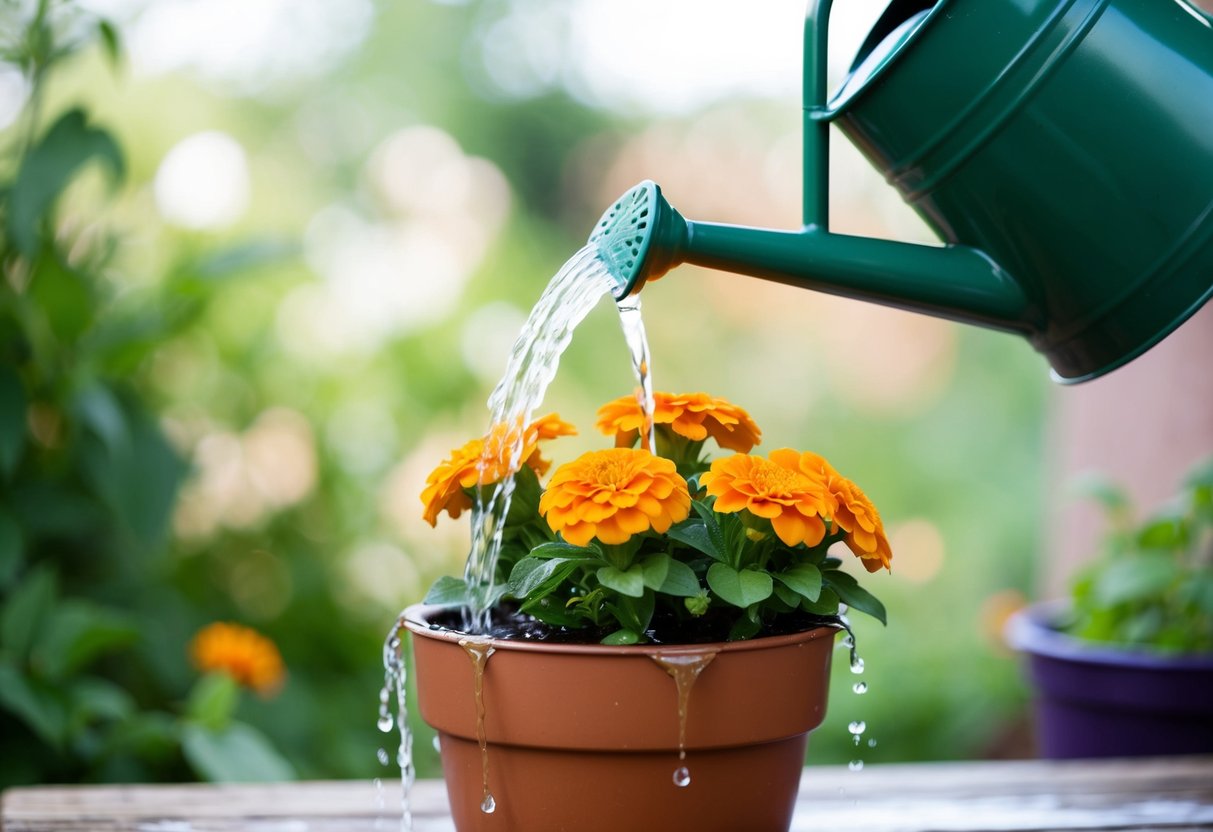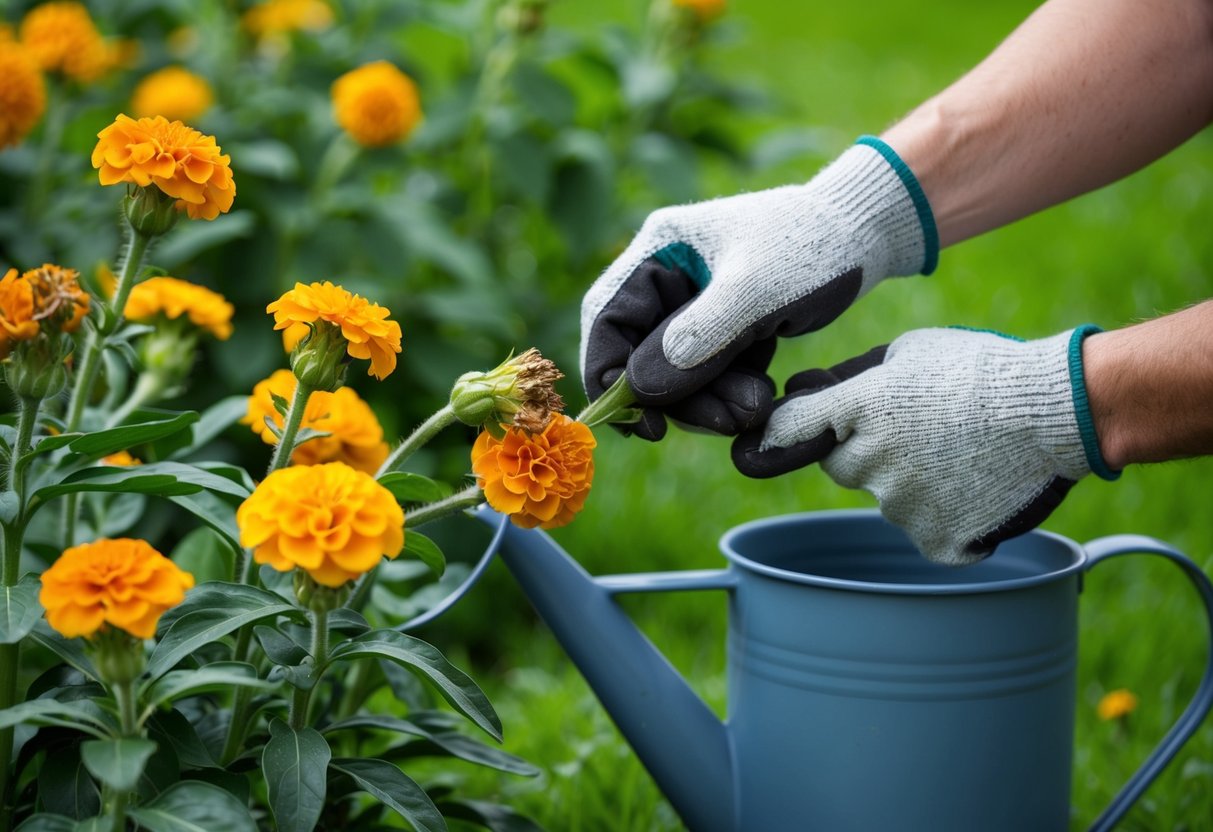How Do You Keep Marigolds From Dying? Simple Strategies for Healthy Blooms
Keeping marigolds alive and thriving in your garden can be a rewarding experience. Regular watering, ensuring the soil dries between sessions, prevents root rot and keeps your marigolds blooming beautifully. Combine this with proper pruning to remove any dead or yellowing leaves.

Pest control is another crucial aspect of marigold care. Watch for tiny green aphids or spider mites that can cause damage. Using natural remedies or insecticidal soap can help protect your plants from these common pests. By creating a healthy environment, you’re paving the way for vibrant marigolds. Set your garden up for success and enjoy the colorful blooms marigolds bring.
Getting Started with Marigolds

When starting with marigolds, you’ll first want to select the right varieties for your garden. Understanding their basic needs, like soil and sunlight, is crucial. Proper planting techniques ensure strong and vibrant growth.
Selecting the Right Marigold Varieties
Choosing the right marigold variety means knowing your options among the Tagetes spp. These include African, French, and Signet marigolds. African marigolds are great for taller displays with large blooms. French ones are smaller but bloom more profusely, making them perfect for borders. Signet marigolds have a more delicate appearance and a citrus-like scent.
Think about the space you have. French marigolds make wonderful bedding plants, while African marigolds stand out due to their height. Each type offers unique colors and sizes, so they can complement your garden beautifully. By picking varieties suited to your garden’s layout and climate, you enhance both aesthetic appeal and plant health.
Understanding Marigold Basics
Marigolds are annuals, which means they last for one growing season. They are hardy and thrive in full sun, needing about 6 to 8 hours of sunlight per day. Plant them in well-draining soil for the best growth. Poor drainage can lead to root diseases.
Although they aren’t too picky about soil quality, adding some potting mix or compost can help. This boosts nutrients and improves drainage. Remember, marigolds are adaptable but benefit from a balanced environment. If you start from seeds, they germinate quickly, usually within 4 to 14 days.
Planting Marigolds Correctly
Proper planting involves timing and method. It’s best to plant marigolds after the last frost date in your area. If you’re planting seeds directly, sow them about half an inch deep into the soil. For young plants, dig a hole deep enough to cover the roots.
Space your marigolds about 6 to 12 inches apart, depending on the variety. This allows for ample air circulation and healthy growth. Keep the soil moist but not waterlogged after planting. By following these steps, you’ll set a solid foundation for your marigolds to flourish.
Watering and Drainage Essentials

Keeping marigolds healthy starts with proper watering and ensuring they have well-drained soil. Learning how to balance water levels is crucial to prevent issues like overwatering or dry soil.
Creating an Effective Watering Schedule
Marigolds need regular watering, especially in hot weather. Aim to water them every other day when temperatures soar. Morning and evening are the best times to water, helping retain moisture and reduce evaporation. The key is to keep the soil moist but not soaked. Use your finger to test soil moisture: if it feels dry an inch below the surface, it’s time to water.
Be consistent. While marigolds are resilient, regular watering builds their strength. During cooler periods, you might water them only a few times a week. Adjust based on your local climate and rainfall. Meetings their water needs is crucial to prevent the negative effects of both overwatering and dry soil.
Preventing Overwatering and Underwatering
Maintaining a balance between overwatering and underwatering is critical. Too much water can lead to waterlogged soil and root rot, while too little results in dry, drooping plants. A simple way to avoid overwatering is to ensure the plant pots have drainage holes.
Look for signs like yellowing leaves and wilting as indicators of poor watering practices. If roots sit in water too long, it can be damaging. Use a self-watering pot or a drip system to keep soil moisture levels even. For underwatering, supplemental watering by mist or light shower helps restore plant health quickly. Your attentive eye will go a long way in spotting and correcting these problems.
Improving Soil Drainage
Soil drainage is a game-changer for marigold health. Start with a well-drained soil mix to provide the best environment. A good mix might include two parts loam, one part peat moss, and one part sand. This combination promises both moisture retention and excellent drainage.
Ensure the planting area allows excess water to escape. This could be on a slope or a raised bed. Avoid heavy clay soils that hold too much water. If your garden area doesn’t drain well, consider adjusting the soil composition or use containers with ample drainage to prevent roots from sitting in water. The aim is to create an ideal balance where soil holds necessary moisture but drains well enough to deter waterlogging.
Fertilization and Soil Management

Keeping marigolds healthy involves using the right fertilizer and ensuring the soil remains rich in nutrients. Provide your marigolds with optimal growing conditions by choosing a suitable fertilization schedule and maintaining soil health with organic materials.
Choosing the Right Fertilizer for Marigolds
When selecting a fertilizer for marigolds, look for a balanced option with an even NPK ratio, such as 10-10-10. This ensures your plants receive equal parts of nitrogen, phosphorus, and potassium, promoting healthy growth and vibrant blooms.
Apply this balanced fertilizer every 4 to 6 weeks during the growing season. Use slow-release granules to provide a steady nutrient supply, which helps prevent nutrient deficiency over time. After applying fertilizer, make sure to water the marigolds thoroughly. This helps integrate the nutrients into the soil and activates the granules.
Maintaining Soil Health with Organic Matter
For optimal soil conditions, incorporate organic matter into your garden. Use materials like organic compost to enrich the soil. Compost boosts soil fertility and improves water retention, helping your marigolds thrive.
You can add organic compost to the soil before planting marigolds or as a top dressing around established plants. This not only feeds your plants but also encourages beneficial microorganisms in the soil. Healthy, rich soil supports robust plant growth and keeps marigolds free from common problems like nutrient deficiencies.
Regularly check and maintain soil conditions, ensuring it’s well-drained and not too compact. This encourages strong root development and minimizes the risk of issues like root rot.
Protecting Marigolds from Pests and Diseases

Keeping marigolds healthy requires vigilance against pests like aphids and spider mites, as well as fungal infections such as powdery mildew. Using natural remedies like neem oil and copper soap, you can safeguard your plants and ensure they continue to flourish.
Identifying Common Pests and Diseases
Marigolds are susceptible to various pests and diseases that can harm their growth. Aphids and spider mites are frequent visitors. You might see yellow or brown speckles on the leaves as a sign of infestation.
Other threats include bacterial leaf spot and root rot, which cause discoloration and wilting. Also, watch out for diseases like aster yellows, which can deform flowers.
Natural and Preventative Pest Control Measures
To protect your marigolds from pests, consider natural methods. Neem oil is effective against many bugs, including aphids and spider mites. It disrupts their growth and repels them from plants.
Copper soap is a gentle option for preventing fungal issues like powdery mildew. It’s safe and easy to apply. Planting marigolds in well-draining soil can prevent problems like root rot caused by overwatering.
Addressing Fungal Infections and Disorders
Fungal infections such as powdery mildew can affect marigold plants. Symptoms include white, powdery spots on leaves. Good air circulation and copper soap application can help.
To manage and prevent bacterial leaf spot, remove affected leaves promptly. Environmental stress, such as too much moisture, can exacerbate these issues. Adjust watering to meet your marigold’s needs and use fungicidal sprays if needed. These practices keep your plants robust and vibrant.
Marigold Pruning and Maintenance Tips

Keeping your marigolds vibrant and healthy involves proper pruning and deadheading. These practices not only enhance blooms but also improve air circulation and reduce the risk of disease. Let’s explore how these techniques help prevent wilting, yellowing leaves, and ensure your marigolds aren’t stunted in growth.
Effective Deadheading for Longer Bloom
Deadheading is essential for encouraging more vibrant colors in marigolds. Remove spent blooms regularly to prevent the plant from channeling energy into seed production. This helps in maintaining a longer blooming period. Look for wilted or browning flowers and snip them off just above the nearest healthy leaf set.
This simple process redirects the plant’s energy towards producing new flowers. Regular deadheading also helps prevent pests and diseases, as decaying flowers can attract unwanted nuisances. By staying on top of deadheading, you encourage your marigolds to keep blooming and stay healthy throughout the season.
Pruning to Promote Healthy Growth and Air Circulation
Pruning marigolds not only shapes them but also promotes better air circulation, helping to prevent disease. Start by removing any yellowing or damaged leaves and stems. Cut back about one-third of the plant to maintain balance and stimulate new growth.
Pruning also keeps the plant tidy and prevents it from getting leggy. By ensuring good airflow, you minimize the risk of fungal problems. Trim any overlapping branches to keep the center of the plant open. This improves sunlight penetration, which is crucial for healthy, stunted growth-free marigolds. Overall, regular pruning keeps your marigolds lush and vibrant.
For more detailed pruning steps, you might find this guide on pruning marigolds helpful. For improving bloom time, check out tips on maximizing flowers.







